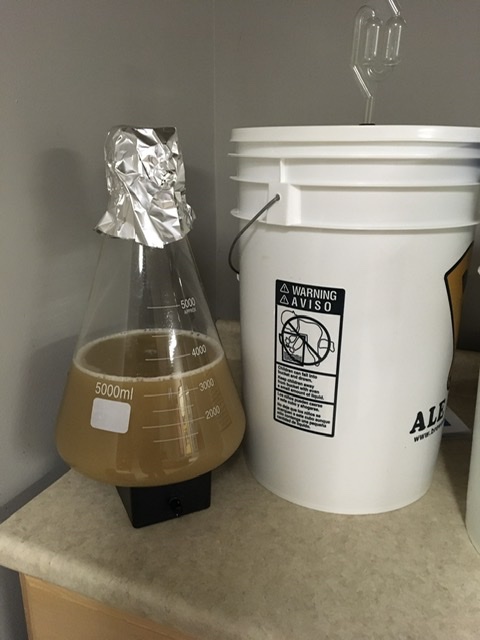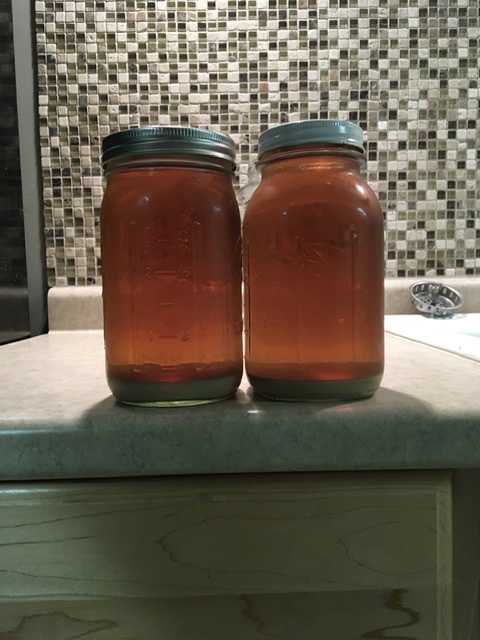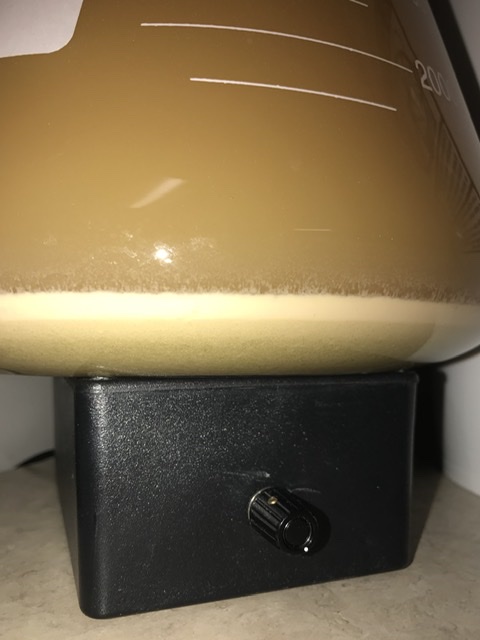Thanks for sharing and rousting the old yeast. Looking forward to the discussion. When you asked about how long of a time period, I would benefit from 2-6 months of storage time as I like to brew different styles with different yeasts.
You are using an out of date browser. It may not display this or other websites correctly.
You should upgrade or use an alternative browser.
You should upgrade or use an alternative browser.
Best yeast washing procedure for harvesting lager yeast.
- Thread starter knollybru
- Start date

Help Support Homebrew Talk:
This site may earn a commission from merchant affiliate
links, including eBay, Amazon, and others.
And they’re off! Did not smell anything scary..in fact had very little smell at all. The diluted beer on top of yeast had oxidized pretty badly but that’s no surprise. I did a 3L 1.025 starter...a little smaller and lower OG than my normal 4L 1.035 starter but have read a little lower OG starter is suggested when trying to revive old yeast.




We have life! I turned stir plate off after about 9 hrs. At about 13hrs the yeast was settling out and the top 1/3 of the starter was clear and things looked totally dormant. I got up this morning and at the 19hr mark it’s all cloudy again and starting to get a little krausen on top. Smells yeasty but other wise OK....woo hoo!




Also, I checked some notes...This is Fermentis Saflager W-34/70. Purchased in April and brewed June 15. That means this yeast was stored for 9 months. I’m impressed at how quickly it seems to be taking off. Ive never done a starter w/ lager yeast but this is not much different than I see w/ 4-8 week old ale yeasts.
Thanks for the followups. Interesting and positive behavior. How do we take this information and verify the yeast is valid, has good viability and is healthy? Are you planning on brewing with it soon? At the homebrew level, judging a beer made with it is kind of the only true gauge.
Some negatives mentioned in this thread are probability of a high number of dead cells and over-stressed cells on revive that would lead to off flavors during fermentation.
Some negatives mentioned in this thread are probability of a high number of dead cells and over-stressed cells on revive that would lead to off flavors during fermentation.
I am soooo glad you asked! I guess the first question we should discuss is what are we trying to prove? So far I know that the “rinsing” process and storing under a diluted solution of the beer results in yeast with some level of health at 9months.
If I were doing this for me alone as part of my normal OCD tendencies i think I would let this starter ferment out for another day or 2, then I would swirl to get everything back into suspension, allow an hour or so to pass, and poor off the creamy part and discard whatI would assert are the dead and/or unhealthy cells which I would tell myself had settled to the bottom.
Then, I’d let that sit in fridge for a few days to condense my fresh healthy yeast. Then I’d do another starter but this would be the 4.5L 1.035 starter I normally do. As this is lager, I would then declare Ive got enough good yeast to properly ferment 10G of lager...if this were Ale yeast I would declare it was enough for 15G and I would plan my brew day.
Many rational people would say Ive already passed the point of value in saving this yeast vs buying fresh. I understand that. Excluding time from the math, I’d say I would still be a little ahead in terms of $$ invested. For 10G of lager you’d need 4 packs of yeast. I think I’ve got less DME $ invested then what 4 packs of yeast would cost.
So....what do you think? Should I go this route or would you suggest something more useful to explore as part of this?
If I were doing this for me alone as part of my normal OCD tendencies i think I would let this starter ferment out for another day or 2, then I would swirl to get everything back into suspension, allow an hour or so to pass, and poor off the creamy part and discard whatI would assert are the dead and/or unhealthy cells which I would tell myself had settled to the bottom.
Then, I’d let that sit in fridge for a few days to condense my fresh healthy yeast. Then I’d do another starter but this would be the 4.5L 1.035 starter I normally do. As this is lager, I would then declare Ive got enough good yeast to properly ferment 10G of lager...if this were Ale yeast I would declare it was enough for 15G and I would plan my brew day.
Many rational people would say Ive already passed the point of value in saving this yeast vs buying fresh. I understand that. Excluding time from the math, I’d say I would still be a little ahead in terms of $$ invested. For 10G of lager you’d need 4 packs of yeast. I think I’ve got less DME $ invested then what 4 packs of yeast would cost.
So....what do you think? Should I go this route or would you suggest something more useful to explore as part of this?

$176.97
1pc Commercial Keg Manifold 2" Tri Clamp,Ball Lock Tapping Head,Pressure Gauge/Adjustable PRV for Kegging,Fermentation Control
hanhanbaihuoxiaoshoudian

$20.94
$29.99
The Brew Your Own Big Book of Clone Recipes: Featuring 300 Homebrew Recipes from Your Favorite Breweries
Amazon.com

$56.70
Wilbur Curtis Thermal Dispenser Seamless Pourpot, 64 Oz, Ss Exterior/Liner, Brew-Thru Lid - Commercial Airpot Pourpot Beverage Dispenser - CLXP6401S100 (Each)
BEACON HILL ( ALL Serial NUMBERS recorded)

$10.99 ($31.16 / Ounce)
Hornindal Kveik Yeast for Homebrewing - Mead, Cider, Wine, Beer - 10g Packet - Saccharomyces Cerevisiae - Sold by Shadowhive.com
Shadowhive

$53.24
1pc Hose Barb/MFL 1.5" Tri Clamp to Ball Lock Post Liquid Gas Homebrew Kegging Fermentation Parts Brewer Hardware SUS304(Gas MFL)
Guangshui Weilu You Trading Co., Ltd

$172.35
2 Inch Tri Clamp Keg Manifold With Ball Lock Posts, Pressure Gauge, PRV (0-30 PSI) – Homebrew, Fermentation, Kegging System
wuhanshijiayangzhiyimaoyiyouxiangongsi

$33.99 ($17.00 / Count)
$41.99 ($21.00 / Count)
2 Pack 1 Gallon Large Fermentation Jars with 3 Airlocks and 2 SCREW Lids(100% Airtight Heavy Duty Lid w Silicone) - Wide Mouth Glass Jars w Scale Mark - Pickle Jars for Sauerkraut, Sourdough Starter
Qianfenie Direct
![Craft A Brew - Safale S-04 Dry Yeast - Fermentis - English Ale Dry Yeast - For English and American Ales and Hard Apple Ciders - Ingredients for Home Brewing - Beer Making Supplies - [1 Pack]](https://m.media-amazon.com/images/I/41fVGNh6JfL._SL500_.jpg)
$6.95 ($17.38 / Ounce)
$7.47 ($18.68 / Ounce)
Craft A Brew - Safale S-04 Dry Yeast - Fermentis - English Ale Dry Yeast - For English and American Ales and Hard Apple Ciders - Ingredients for Home Brewing - Beer Making Supplies - [1 Pack]
Hobby Homebrew

$58.16
HUIZHUGS Brewing Equipment Keg Ball Lock Faucet 30cm Reinforced Silicone Hose Secondary Fermentation Homebrew Kegging Brewing Equipment
xiangshuizhenzhanglingfengshop

$7.79 ($7.79 / Count)
Craft A Brew - LalBrew Voss™ - Kveik Ale Yeast - For Craft Lagers - Ingredients for Home Brewing - Beer Making Supplies - (1 Pack)
Craft a Brew

$53.24
1pc Hose Barb/MFL 1.5" Tri Clamp to Ball Lock Post Liquid Gas Homebrew Kegging Fermentation Parts Brewer Hardware SUS304(Liquid Hose Barb)
yunchengshiyanhuqucuichendianzishangwuyouxiangongsi

$22.00 ($623.23 / Ounce)
AMZLMPKNTW Ball Lock Sample Faucet 30cm Reinforced Silicone Hose Secondary Fermentation Homebrew Kegging joyful
无为中南商贸有限公司
I think this is a pretty good opportunity to learn some things. 9 months and lager yeast is a strong test. My knowledge of re-pitching is nill as I always have purchased new, but I am interested in longer storage. Hopefully we can get some more folks involved.
Maybe make a new thread in this forum with a title like "I have 9 month old washed lager yeast, how to check its health & use?" Or something of the sort. A lot of folks would benefit from this and if it does result in a working situation, my habits would change.
I am unsure about separating new and old yeast in the same container. That seems like a tough one. A mini conical would be nice to have. Mason jar conical?
Maybe make a new thread in this forum with a title like "I have 9 month old washed lager yeast, how to check its health & use?" Or something of the sort. A lot of folks would benefit from this and if it does result in a working situation, my habits would change.
I am unsure about separating new and old yeast in the same container. That seems like a tough one. A mini conical would be nice to have. Mason jar conical?
I like the idea of new thread. Can you expand a bit on the mason jar conical? Separating the old and new yeast is what I thought I would be attempting (dare I say approximating?) by swirling the starter and then allowing an hr or so for things to settle and then poor off the top ~2L or so leaving ~1L or so behind.
Would you have any idea if this would be remotely effective? Maybe this where the broader audience would contribute?
Would you have any idea if this would be remotely effective? Maybe this where the broader audience would contribute?


I noticed 3 distinct layers at the bottom. I tried to get a close up so you could see it also. It sort of give me optimism about the swirl...settle..and door off approach may have merit
New thread started...
https://www.homebrewtalk.com/forum/threads/reusing-9month-old-lager-yeast.676557/
https://www.homebrewtalk.com/forum/threads/reusing-9month-old-lager-yeast.676557/
I do not know about the swirl method. It would seem the three layers are trub at the very bottom, old yeast in the middle and newly created yeast on top? This does not necessarily mean the old yeast is dead though.?
I was joking about the mason jar conical. Might be nice to have a micro conical for yeast ranching though.
I was joking about the mason jar conical. Might be nice to have a micro conical for yeast ranching though.
Similar threads
- Replies
- 3
- Views
- 1K
- Replies
- 13
- Views
- 2K
- Replies
- 19
- Views
- 1K













































